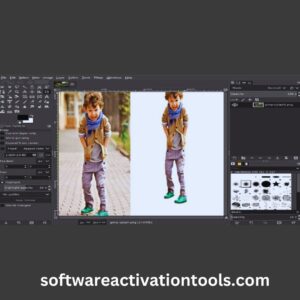When it comes to editing images, there are several techniques available for removing unwanted portions. One effective approach is to enhance the main focal point of your image by adding a picturesque background or captivating elements, which can increase its intrigue. This not only improves the overall composition but also makes the image more visually appealing to viewers. You can follow these additions in GIMP Background Removal. To begin the editing process, open the image in a suitable editing program such as Adobe Photoshop or GIMP Background Removal. Then, utilize the magic wand tool by selecting it and clicking on the background you wish to remove.
This tool makes it easy to deselect unwanted sections swiftly, saving you valuable time and effort. Lastly, save the image in a format that supports transparency, like PNG or GIF. By following these straightforward steps, you can effortlessly create an image with a transparent background for your design projects.
However, GIMP background removal is an incredibly popular and viable open-source software that serves as a perfect alternative to Adobe Photoshop. This well-loved app is utilized by millions of people on a daily basis. Why spend a fortune on software when you can enjoy the same features for free? Give GIMP background removal a try and discover the same level of professionalism and accuracy that Photoshop provides. If you are new to GIMP background removal or are currently learning image processing, it’s worth familiarizing yourself with the steps to make any part of a complex image transparent, including the background. This skill will enable you to create more refined and professional images, which can be particularly valuable for marketing materials or websites.

How To Use Gimp Background Removal:
Removing the background using GIMP is a quick and straightforward process that won’t consume much of your time. By following a few simple steps, you can efficiently eliminate the background from your image. The key to successful background removal lies in selecting the appropriate method that suits the unique features of your image. Fortunately, GIMP offers a variety of methods and tools for selection, ensuring precise and accurate cutouts.
One effective way to select objects in an image is by utilizing the Fuzzy Select tool. This tool is particularly useful for choosing areas with similar colors and textures. It operates by selecting pixels that closely resemble the initial pixel you click on. This method proves excellent for swiftly and accurately selecting large areas of an image.
By using the fuzzy select tool:
Let’s explore the color pixel selection method by using the official EDUCBA logo image. By practicing this technique, we can develop a better understanding of its functionality. To get started, locate the Fuzzy Select tool in the Tool panel. For a more precise selection, it’s recommended to enable the antialiasing and Draw mask options, which can be found in the parameters panel. Enabling antialiasing will result in smoother edges for your selection.
To remove the desired background from GIMP Background Removal, simply click on it while holding down the mouse button. Your selection will be highlighted in a vibrant magenta color. If needed, you can click multiple times to ensure the correct background is chosen. Additionally, the tool provides comprehensive information and helpful tips on effectively utilizing the Fuzzy Select tool.

By using the select by the color tool:
To improve the visual quality, please enable the antialiasing feature. Additionally, remember to activate the draw mask option and adjust the feather setting for this tool in the parameters section. To accurately select the background of your image, click on it and drag your mouse along the edges. This ensures a precise selection of the entire background without including any other elements. The selected area will be highlighted in a vibrant magenta color. Release the click to complete the selection.
To create a transparent background in GIMP Background Removal, go to the layer panel and right-click on the desired layer for editing. From the options, select “Add Alpha channel” to make the background transparent. To remove the background, press the delete button. This will provide you with a clear and clean image, free from any distracting background elements. Pressing the delete button will disable the selection around your object.
To finalize the process, go to the Select menu and choose the None option to remove the selection around your object. Now, your object is ready for use. Get excited, as you’re just one step away from showcasing your amazing creation! Let’s proceed to the next method by starting fresh with a new image. This time, we’ll utilize the Paths Tool.
By using the paths tool:
The Path tool is exceptionally precise, allowing you to create a clean and accurate path around the edges of the main object in your image. This feature is vital for achieving precise and professional-looking results. To access the Path tools, navigate to the tool panel.

To remove the background from the half-moon image in GIMP Background Removal, let’s make a selection by clicking along its edges. This will isolate the moon and remove any unwanted elements from the picture. Taking your time and being cautious with each click will ensure a precise and polished outcome. Once you have created a boundary around your object, press and hold the Ctrl key on your keyboard and click on the initial point of your path to finalize it. The path tool allows you to modify the curve of your object at any point, even after creating the path. This makes it effortless to refine the shape and contour of your object to your desired specifications. Whether you are a beginner or an experienced user, this simple yet powerful tool makes it easy to achieve professional-looking results with ease.
To convert the path into a selection, press the enter key. Additionally, to isolate an object, it is necessary to remove the background. To do this, access the Select menu and choose the Invert option. This will shift the focus of the selection from the object to the surrounding background. To create a transparent background, click on the “Add Alpha Channel” option. This allows your image to have fully transparent areas and others that remain opaque.
By adding Layer mask:
This technique allows us to remove the background from objects with intricate or hair-like structures that cannot be easily selected using the paths tool. For the following steps, I have selected this specific image.
To begin, let’s make a duplicate of the image. Afterward, we will convert the image to black and white. To adjust the color saturation, go to the Colors option in the menu bar and select Saturation. Set the scale value to 0.00 and click the Ok button in the dialog box.

Next, to access the Curves tool, go back to the Colors menu and select it from the drop-down list. The Curves tool enables you to enhance the brightness and contrast of your image by adjusting the highlights and shadows. Let’s modify the curve to increase the black space covered by our object.
For this technique to work effectively, the image used should have a distinct contrast between the foreground and the background. Once you have made your selection, it will be highlighted with an inverted color effect, similar to the one shown here. Furthermore, to capture a portion of your screen in GIMP Background Removal, navigate to the Edit menu and choose the “Copy Visible” option.
To hide a layer in the panel, simply click on the eye icon next to it. This will remove it from view, but it will still remain in the layer stack. To add a mask to the original layer, right-click on the layer and select the “Add Layer Mask” option.
By following these simple steps, you can create a stunning and polished final product that serves multiple purposes and exudes a professional touch.
Conclusion:
If you wish to remove the background of a specific object in a photo through GIMP Background Removal, there are several effective methods available to you by adjusting the parameters of the tool. By carefully selecting the desired object, you can effortlessly eliminate the remaining background. Moreover, these techniques are useful for anyone who wants to extract an object from a photo and utilize it in a different image or context. So, go ahead and give it a try! You won’t be disappointed.
However, To become proficient in various techniques in GIMP Background Removal, it is crucial to practice them individually. By honing your skills in each method, you will gain mastery over them and develop a strong grasp of their functionalities.

Frequently Asked Questions:
Q: Does GIMP have a background remover?
A: Absolutely! You don’t have to spend valuable time manually selecting each pixel anymore. Save time and unleash your creativity instead. Removing backgrounds from photos can be a tedious task but with the removal.bg plugin for GIMP, you can remove image backgrounds automatically in a matter of seconds! This incredible tool is a game-changer for those who require fast and effortless photo editing.
Q: Is GIMP software free?
A: Yes, GIMP software is completely free of charge. Not only can you use it without any cost, but you also have the freedom to modify its source code according to your preferences and share your improvements with others.
